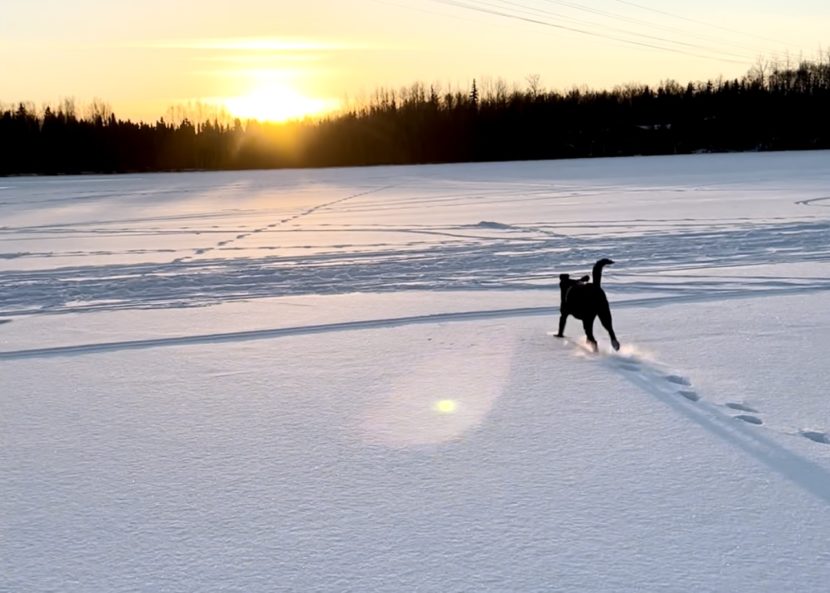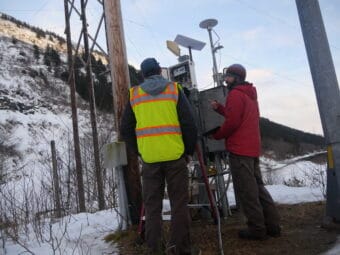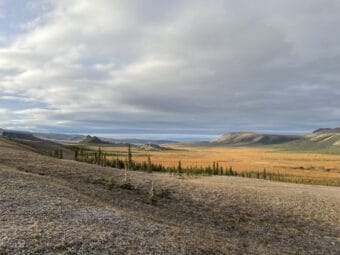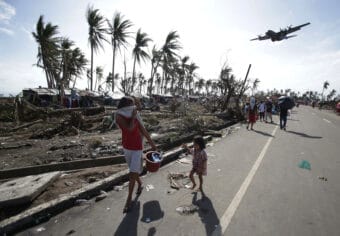
What is winter anyway?
For a lot of Alaskans, it’s a season that’s not entirely defined by a specific period on the calendar as much as, you know it when you see it. The snow-covered landscape. The frosty breath. Maybe sea ice forming on the coastline.
It’s safe to say we’re seeing some of that already this winter, but whether the wintry weather remains is a question people like National Weather Service climate researcher Brian Brettschneider are pondering.
Brettschneider — back for our Ask a Climatologist segment — points to the National Oceanic and Atmospheric Administration’s long-term forecast for a third La Niña winter in a row, but he says we can’t draw too many conclusions from the winter we’ve seen so far.
Listen:
Brian Brettschneider: So for example, last winter, November was the coldest month of the winter for many locations in the southwestern, say, quarter of the state. And the thinking was, you know, this is a real harbinger for: It’s going to be just a brutally cold winter. And it turned out to be, especially in the southern mainland, you know, like a top 10 warmest winter. So we need to keep that in mind.
So NOAA just came out with their seasonal outlooks, and they look at a couple of things. There’s always going to be uncertainty on what happens on relatively short timescales. We don’t know where the jet stream is going to be and what the trajectory of sea ice is going to be and so on. But the largest contributor to the seasonal forecast is La Niña. And more times than not, La Niña winters are colder than average in Alaska. Not every time but a majority of times. So that represents about 40% of the variability.
Another important factor is the evolution of sea ice in the Chukchi Sea and then the the Bering Sea. And it’s kind of getting a late start right now. And when that water is open with no ice on it, there’s a lot of heat that can be liberated into the atmosphere, and it keeps things warm.
And then the other thing is trend. The trend is warming. You know, if you just woke up from a coma, and someone said, “What do you think it’ll be? What do we think the winter will be like? You should probably say, “I don’t know, but it’s probably going to be warmer than winter used to be,” just because things are warmer now.
So those are the three things that go into our winter outlook. And if you look at the winter outlook this year, it shows colder than normal temperature, or below normal, is favored in Southeast Alaska. Above normal temperatures are favored on the west coast and North Slope, and that’s driven largely by the trends, recent trends, and sea ice. And kind of what we call equal chances, so no signal for either above or below for, you know, the the other 50% of the state in between Southeast and Northwest.
Casey Grove: You mentioned the trend, and just riffing off of, you know, “If you woke up from a coma” — What if you had been frozen in ice, you know, hundreds of years ago, and you woke up? You just thawed out. What would you think was going to happen with the winter?
Brian Brettschneider: So let’s say, for example, this winter ends up being — and I’m just going to make this number up — 2 degrees colder than normal. Well, if this person had been frozen in ice, you know, 100 years ago, and we replaced that winter 100 years ago with this winter, what we would think of as being cold, they would think of as, “Whoa, that was a pretty mild winter.” Just because it used to be a lot colder back then. So we do need to keep that in mind, that there is this temporal perspective. We’re now used to this this new warmer world, and so if we’re a little cooler than our new normal, that still might be much warmer than it used to be in a typical year.
Casey Grove: Do you think that person would look around at us now, those of us who have complained about this recent snow and the cold, that they would think that we were wimps?
Brian Brettschneider: The snow is trickier. You know, we’ve managed to hold onto our snow totals over time, although the snow has been squeezed, on average, into fewer days of the year. So we start our snow season a little bit later, and we end it a little bit earlier. The core snow months are hanging in there and actually have gotten a little bit snowier. But that can only last for so long. You know, eventually, if things continue to warm, we would transition more of that snow into rain. Which, you know, I don’t know of anyone that likes rain in the winter. There’s just nothing good about winter rain.
Casey Grove: Yeah, definitely. I feel like we’ve established that, for sure.
Getting back to this thawed-out person bit that I should have let go a long time ago. So maybe it’s more like they look around at us complaining — not us, but people who have complained about snow right at the beginning of November — and they would say, “Well, that’s at least later than it used to be when I was in my prime, a pre-frozen person.”
Brian Brettschneider: Well, even as recently as several decades ago, if you said, “Well, what’s the snowiest month of the year around Alaska?” For the northern half of the state, October was the snowiest month of the year. That’s not the case anymore. There’s almost no location where October is the snowiest month. And again, this is like in the ’80s and ’90s. This isn’t like 100 years ago, this is very recently. But now what we’re seeing is a lot of what used to fall as snow in October is now falling as rain. So, you know, if you warm things up 3, 4 or 5 degrees, what used to be a 30-degree snow is now a 35-degree rain. That’s shifted. So that’s something that someone from 100 years ago would probably notice, and the later freeze up of rivers and so on, because the darkness doesn’t change. It still gets dark at the same time it did 100 years ago, but we’re just not quite as cold.
Casey Grove: That’s interesting to think about. I didn’t anticipate a frozen person coming into this.
Brian Brettschneider: But here we are.
Casey Grove: Well, thanks for bearing with me on that.



